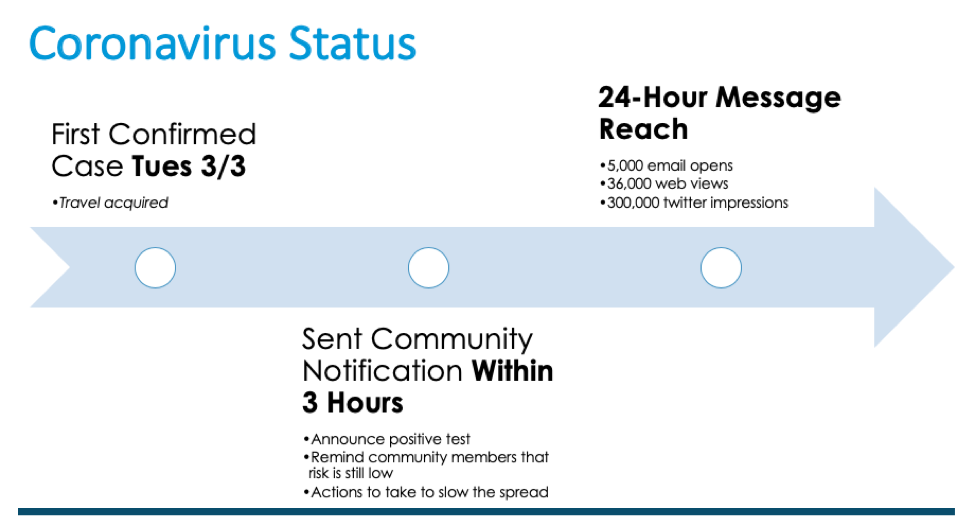
California was the first state in the U.S. to see a patient test positive for coronavirus due to community spread. At the City of Berkeley, the communications team found themselves in a position many government leaders are facing: they needed to communicate about coronavirus quickly, accurately, and effectively.
In a recent webinar sharing best practices for responding to the COVID-19 outbreak, Echa Schneider, digital strategist at the City of Berkeley, California, shared strategy and tips for communicating about coronavirus, as well as what they did after finding out there was one reported case of coronavirus.
According the Schneider, the City of Berkeley activated their emergency operations center over a month before the first confirmed case. Within hours of finding out a member of the community tested positive for the virus, City staff sent email and social media notifications to residents.

A partial screenshot of Berkeley’s first govDelivery notification to residents. See the whole message >>
The email notification announced the positive test with facts around the case, communicated actions the city was taking, and reminded citizens that while the risk was low, they could prepare by taking the suggested action in the email. The notification also offered credible resources for accurate information.
In addition to the email, they distributed messaging via their website and social media platforms. The strategic combination of communication channels helped them reach more members of their diverse community quickly, said Schneider. They dedicated a webpage on their website to coronavirus information and updates. The City also developed print material to reach community members that may not have internet access. Berkeley posted a CDC poster, which demonstrates proper hand washing techniques, in every public bathroom in the City.

Within 24 hours, Berkeley’s notification had 5,000 email opens, their landing page had 36,000 web views, and their Twitter post had 300,000 impressions.
In the webinar, Schneider also shared helpful tips to consider when putting together your own communications.
Schneider suggested you start with “the why.” Your audience has competing messages vying for their attention. Why is it important that your audience receives your message? You should also consider who you want your message to reach, she said. How will you effectively reach them and make your message heard?
Schneider said it’s essential to build trust. Prior to this public health crisis, the City built rapport with its audience. Residents know that a message from the City will not waste their time and will be useful. They will pay attention.
While you can’t go back in time to build rapport, Schneider said you can build trust by maintaining a consistent pace with messaging. Don’t bombard your audience with information all at once; support them as events occur. Speak directly to your audience by using first person and second person (I, we, you), and use a helpful tone, she said.
An easy way to combat misinformation, Schneider said, is to elevate the voices of public health authorities. Use their messaging and repost their announcements. Provide your community members with links to credible websites.
People feel empowered when they can protect themselves, said Schneider. Provide residents with steps to lower risk of infection. Let them know what they should do if they get sick. Give them resources to learn more.
Schneider reminded attendee that you don’t have to create all your content from scratch. Use pre-existing resources from trusted organizations. Berkeley posted a CDC poster, which demonstrates proper handwashing techniques, in every bathroom in the city. Schneider also encourages you to share resources with peer agencies.
Each community is unique. Consider what avenues have worked well in the past with your community and use them now. Your messaging should also align with the values of your community. If you try something new during this time, take note of its success. If it works well, you can add it to your toolkit for next time.
[COVID-19 POLL: How Are You Communicating With Your Community?]
By responding quickly and effectively using a variety of communications channels, the City of Berkeley provides an outstanding example for how to communicate with residents during a public health crisis. They were able to get their message out, provide support, and build the rapport and trust that is critical when crisis strikes.
Watch the free webinar, “Communicating During a Public Health Crisis.”
At Granicus, we’re partnering with governments across all levels with tools and digital services to help inform, educate, and keep residents safe. Contact us >>